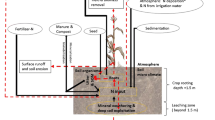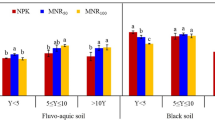Abstract
Leaching losses of N and P were examined in separately tile-drained field plots on a clay soil with two 6-year organic crop rotations (1998–2006). Two different farming systems (with dairy cows (+L) and without stock (−L)) were evaluated to identify parts of the crop rotations with the greatest risks of N and P leaching losses and to examine the scope for improvement. Although N and P leaching losses tended to be higher without livestock, the mean annual leaching loads from both systems were low and did not differ significantly (6.8 and 9.1 kg N ha−1 year−1 and 0.39 and 0.55 kg P ha−1 year−1 for +L and −L, respectively). For both systems, there were increased amounts of N and P in drainage water in the period following sowing of winter wheat after incorporation of clover–grass ley (CG). This could be attributed to the early date of CG incorporation, as late incorporation followed by bare fallow gave lower nutrient leaching. Drainage from bare fallow after a broad bean crop was identified as a critical part of the crop rotation for P leaching, with P losses possibly enhanced by macropore formation by the taproot of broad bean. The lowest leaching losses were observed during CG growth, demonstrating that CG had a buffering effect on leaching during heavy precipitation events. It was concluded that in organic farming on clay soils, countermeasures such as undersown CG and late incorporation of this CG can be effective in reducing N and P leaching losses.




Similar content being viewed by others

References
APHA, American Public Health Association (1985) Standard method for the examination of water and waste water. APHA, New York
Askegaard M, Olesen JE, Kristensen K (2005) Nitrate leaching from organic arable crop rotations: effects of location, manure and catch crop. Soil Use Manag 21:181–188
Bergström L, Jarvis N, Stenström J (1994) Pesticide leaching data to validate simulation models for registration purposes. J Environ Sci Health 29:1073–1104
Djuurhus J, Olsen P (1997) Nitrate leaching after cut grass/clover leys as affected by time of ploughing. Soil Use Manag 13:61–67
Dreymann S (2005) N-Haushalt unterschiedlich bewirtschafteter Rotklee-Bestände und deren Bedeutung für die Folgefrucht Weizen im Ökologischen Landbau. Ph.D. thesis, University of Kiel, Germany
ECS, European Committee for Standardisation (1996) Water quality. Determination of phosphorus. Ammonium molybdate spectrometric method. European standard. EN 1189. ECS, Brussels
Egnér H, Riehm H, Domingo WR (1960) Untersuchungen über die chemische Bodenanalyse als Grundlage für die Beurteilung des Nährstoffzustandes der Böden. II. Chemische Extraktionsmethoden zur Phosphor- und Kaliumbestimmung. Kungliga Lantbrukhögskolans annaler 26:199–215
Francis GS, Haynes RJ, Sparling GP, Ross DJ, Williams PH (1992) Nitrogen mineralization, nitrate leaching and crop growth following cultivation of a temporary leguminous pasture in autumn and winter. Fertilizer Res 33:59–70
Francis GS, Haynes RJ, Williams PH (1994) Nitrogen mineralization, nitrate leaching and crop growth after ploughing-in leguminous and non-leguminous grain crop residues. J Agric Sci Cambr 123:81–87
Frankow-Lindenberg BE (2003) Kvantifiering av kvävefixering via baljväxter i fält—förslag till ny modell i rådgivningsprogrammet STANK. SLU Rapport 5. Dept. of Ecol and Crop Prod Sci, SLU, Uppsala
Goss MJ, Howse KR, Christian DG, Catt JA, Pepper TJ (1998) Nitrate leaching: modifying the loss from mineralized organic matter. Eur J Soil Sci 49:649–659
Granstedt A, Baeckström GL (2000) Studies of the preceding crop effect of ley in ecological agriculture. Am J Alternative Agr 15:68–78
Haas G (2001) Organischer Landbau in Grundwasserschutzgebieten: Leistungsfähigkeit und Optimierung des pflanzenbaulichen Stickstoffmanagements. Köster, Berlin
Heß J (1989) Kleegrasumbruch im Organischen Landbau: Stickstoffdynamik im Fruchtfolgeglied Kleegras–Kleegras–Weizen–Roggen. Ph.D. thesis, University of Bonn, Germany
Heß J (1995) Residualer Stickstoff aus mehrjährigem Feldfutterbau: Optimierung seiner Nutzung durch Fruchtfolge und Anbauverfahren unter den Bedingungen des Ökologischen Landbaus. Wissenschaftlicher Fachverlag, Niederkleen
Høgh-Jensen H, Schjoerring JK (1997) Residual nitrogen effect of clover-ryegrass swards on yield and N uptake of a subsequent winter wheat crop as studied by use of 15N methodology and mathematical modelling. Eur J Agron 6:235–243
SAS Institute, Inc (2004) SAS OnlineDoc 9.1.3. SAS Institute, Cary
Kirsten WJ, Hesselius GU (1983) Rapid automatic, high capacity Dumas determination of nitrogen. Microchem J 28:529–547
Korsaeth A (2008) Relations between nitrogen leaching and food productivity in organic and conventional cropping systems in a long-term field study. Agr Ecosyst Environ 127:177–188
Kutschera L (1960) Wurzelatlas mitteleuropäischer Ackerunkräuter und Kulturpflanzen. DLG, Frankfurt am Main
Lindén B, Wallgren B (1993) Nitrogen mineralization after leys ploughed in early or late autumn. Swed J Agr Res 23:77–89
Lütke Entrup N, Schlautmann C, Gröblinghoff F-F (1998) Ackerbohnenanbau mit Grasuntersaaten—Ertragsleistung, Stickstoffixierung und Nachwirkung in verschiedenen Anbausystemen. Vorträge für Pflanzenzüchtung 44:35–47
Nykänen A, Granstedt A, Jauhiainen L, Laine A (2008) Residual effect of clover-rich leys on soil nitrogen and successive grain crops. Agr Food Sci 17:73–87
Retzer F, Fischbeck G (1993) Stickstoffverwertung und -verluste bei Winterweizen mit verschiedenen Düngungsstrategien. Mitteilungen Gesellschaft Pflanzenbauwissenschaften 6:49–52
SCB, Statistiska centralbyrån (2008) Skörd för ekologisk och konventionell odling. Statistics Sweden’s website. http://www.scb.se/Pages/Product____93032.aspx?Produktkod=JO0608&displaypublications=true. Accessed 7 Jan 2011
Shang C, Caldwell DE, Steward JWB, Tiessen H, Huang PM (1996) Bioavailability of organic and inorganic phosphates adsorbed on short-range ordered aluminium precipitate. Microb Ecol 31:29–39
Sharpley AN, Chapra SC, Wedepohl R, Sims JT, Daniel TC, Reddy KR (1994) Managing agricultural phosphorus for protection of surface waters. J Environ Qual 23:437–451
Stinner W, Möller K, Leithold G (2008) Effects of biogas digestion of clover/grass-leys, cover crops and crop residues on nitrogen cycle and crop yield in organic stockless farming systems. Eur J Agron 29:125–134
Tecator (1984) Tecator application note ASN 50-01/84. Tecator AB, Höganäs
Ulén B, Jakobsson C (2005) Critical evaluation of measures to mitigate phosphorus losses from agricultural land to surface waters in Sweden. Sci Total Environ 344:37–50
Ulén B, Persson K (1999) Field-scale phosphorus losses from a drained clay soil in Sweden. Hydrol Process 13:2801–2812
Ulén B, Shirmohammadi A, Bergström L (1998) Phosphorus transport through a clay soil. J Environ Sci Heal 33:67–82
Ulén B, Aronsson H, Torstensson G, Mattson L (2005) Phosphorus and nitrogen turnover and risk of waterborne phosphorus emissions in crop rotations on a clay soil in southwest Sweden. Soil Use Manag 21:221–230
Withers P, Jarvis SC (1998) Mitigation options for diffuse phosphorus loss to water. Soil Use Manag 14:186–192
Acknowledgments
This work was funded by the Swedish Board of Agriculture and the Swedish University of Agricultural Sciences, to which we express our sincere thanks. We would also like to thank Johan Roland and Rolf Tunared who were responsible for planning and field work at Lanna experimental station and Stefan Ekberg, Annelie Mejbert, Amanuel Tesfamikel, Rose-Marie Ericsson and Allan Lundkvist for performing the analyses. Thanks are also due to Mary McAffee for proofreading the English text.
Author information
Authors and Affiliations
Corresponding author
Rights and permissions
About this article
Cite this article
Neumann, A., Torstensson, G. & Aronsson, H. Losses of nitrogen and phosphorus via the drainage system from organic crop rotations with and without livestock on a clay soil in southwest Sweden. Org. Agr. 1, 217–229 (2011). https://doi.org/10.1007/s13165-011-0017-0
Received:
Accepted:
Published:
Issue Date:
DOI: https://doi.org/10.1007/s13165-011-0017-0



